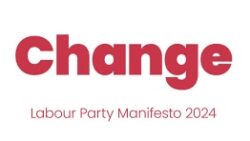If opinion polls are to be believed, Labour is on course for a significant election victory. But what should the left make of its policy offer and its prospects for government? WILL BROWN casts his eye over the party’s pledges.
There were few surprises when Keir Starmer unveiled Labour’s general election manifesto at Co-operative headquarters in Manchester on 13 June. The party ground through its policy-making process over three years prior to annual conference last October and the leadership spent the intervening time diligently trimming key areas into a manifesto package finally agreed at the party’s ‘Clause V’ meeting in early June.
 Reception on the party’s left was underwhelming and, rather unusually, the Unite union refused to fully endorse it, criticising what it saw as a watered down new deal for workers and opposing Labour’s plan to phase out new oil and gas licenses.
Reception on the party’s left was underwhelming and, rather unusually, the Unite union refused to fully endorse it, criticising what it saw as a watered down new deal for workers and opposing Labour’s plan to phase out new oil and gas licenses.
The manifesto highlights the party’s six ‘first steps’: creating economic stability, cutting NHS waiting times, improving border security, setting up Great British Energy, combatting anti-social behaviour and recruiting more teachers. These closely map onto Starmer’s ‘five missions’ announced in July 2023 and form the core sections of the manifesto.
These five areas are top and tailed by commitments to be a ‘mission-driven government’, to provide ‘strong foundations’ through economic stability, to constitutional reform (‘Serving the country’) and to international policy (‘Britain reconnected’) – all wrapped up by a statement on Labour’s ‘fiscal plan’.
Tax, spending & growth
To detail all the left of centre policies that could or should have been included would be an endless task. The key areas that have attracted comment from the left include overall economic policy, taxation and public spending, not least Labour’s steadfast refusal to countenance income tax, national insurance or VAT rises.
A chorus of voices have argued that Labour will need to make bolder tax pledges if it is to realise its other goals, including the IPPR which has proposed raising taxes on income derived from wealth at the same rate as income from work. Others claim that changes to how government borrowing is calculated could open up more space for Rachel Reeves to increase spending and that wealth taxes could substantially increase revenue.
Without such tax income, a Labour government will be relying solely on economic growth. Here the target is bold, as it aims to have the ‘highest sustained growth’ in the G7. How this would be measured isn’t clear (what is sustained growth?), and anyway it isn’t entirely within Labour’s gift to achieve.
Granted, growth rates in the G7 are sluggish – all European countries in the G7, and the Eurozone as a whole, are currently below 1% with only the US forecast by the IMF to reach 2.7% in 2024. This means it wouldn’t take much to improve the UK’s current position (sixth out of seven, on 0.5%) and the gap between the UK and the US isn’t a chasm.
But that in itself is a problem because the UK needs growth externally, as well as change internally, if Labour is to revitalise the UK economy. A huge amount rests on what some are predicting to be a post-election ‘bounce’.
All of Labour’s other goals – on public services, prosperity and standards of living – are dependent on growth. Many social democratic governments including those of Attlee, Wilson, Callaghan and Brown, have foundered on similar rocks.
Health service
Any spending constraints will most keenly be felt and judged in the NHS. While some have hailed the manifesto’s health service goals as a ‘transformative shift from cure to prevention’, others are more sceptical. As it stands the planned increases in NHS funding – limited though they are – are dependent on changes to the non-dom tax rules delivering the desired revenue.
While welcoming some of the manifesto pledges, the Socialist Health Association has warned that the NHS faces further decline without more significant increases in resources, a view echoed by the Nuffield Foundation and the King’s Fund.
Environment
Much has already been written about Starmer and Rachel Reeves’s decision to reduce the £28bn funding once promised for the ‘green new deal’. Nevertheless, some important environmental pledges remain, including to set up Great British Energy, achieve a zero-carbon electricity system by 2030, greatly expand of onshore and offshore wind power, and insulate Britain’s homes (although this commitment has also been reduced). These moves have been welcomed by some even If they can only be viewed as first steps towards tackling the climate crisis.
 Net zero has been the focus of a long-running internal battle in Labour between climate activists and unions such as Unite and the GMB who want to defend jobs in the North Sea oil fields. Indeed, evidence of union opposition to green new deal policies is clear in the manifesto, which pledges that North Sea oil and gas production will continue ‘for decades to come’.
Net zero has been the focus of a long-running internal battle in Labour between climate activists and unions such as Unite and the GMB who want to defend jobs in the North Sea oil fields. Indeed, evidence of union opposition to green new deal policies is clear in the manifesto, which pledges that North Sea oil and gas production will continue ‘for decades to come’.
Locating Great British Energy headquarters in Scotland, where the ‘North Sea lobby’ is strongest, is probably an electorally savvy move, and it surely makes sense to manage the ‘green transition’ in a way that avoids the social collapse that accompanied the decline of heavy industry in the 1970s.
Wider pledges
Although unions were unhappy with what they saw as a watered down commitment to abolish zero-hours contracts, and the manifesto is strongly pro-business, significant aims to increase workers’ rights, and expand the power and role of the state, remain.
There are also some significant reforms proposed within and beyond the five core policy areas. These include reform of the House of Lords – to remove the remaining hereditary peers and require all Lords to retire once they reach 80 – plus a consultation on replacing the chamber entirely. Labour will also reduce the voting age to 16.
On international issues, Labour has committed to recognising a Palestinian state ‘as a contribution to a renewed peace process which results in a two-state solution’ with a safe and secure Israel alongside a viable and sovereign Palestinian state.
On the other hand there is no commitment to re-establishing the Department for International Development and only a vague pledge to meet the 0.7% target for international aid “as soon as fiscal circumstances allow” (these two had been mainstays of Labour manifestos for the past four elections).
Evaluation
In evaluating the overall package, many have understandably found it wanting. Aditya Chakrabortty has argued that Starmer’s manifesto is closer to that of Tory Ted Heath than Labour’s Harold Wilson. However, that argument rather misses the point that those elections took place in an era when much greater swathes of the economy were in public hands and there was a shared commitment to using the state directly to manage economic cycles.
Perhaps more instructive is a comparison with Tony Blair. In terms of electoral strategy, Starmer clearly shares much with Blair, and his backers on the right of the party are carriers of that flame. Accepting Tory tax and spending limits, and prioritising Tory voters and support from business are central to the strategy.
Nevertheless, increasing the role of the state, nationalising the railways and committing to improve workers’ rights are ‘hardly devoid of social democratic purpose’, as John Harris put it.
Future prospects
Whatever our reservations about the manifesto, a great deal rests on its success. A failure to change the political mood and deliver on key areas such as the cost of living and the NHS will make the election after this one a dangerous affair.
Whether or not there is a Tory meltdown on election night, the right will regroup. Whether it’s in Reform or under a Farage-like Tory leader, the extremist tendencies on the right of British politics will be waiting to feed on Labour failures, cheered on their allies abroad and in the right-wing media. And the clock will be ticking. As George Dibb wrote on Labour List, ‘voters don’t have the patience to wait ten years to see these promises delivered’.
In the immediate term, however, none of this is reason to withhold support for Labour. The manifesto comparison that really matters is with the current Tory offer as the Tories are the only other party that could conceivably form a government after this election.
By that measure, none on the left should have qualms about voting Labour. This remains the case even if, given the implosion of the Conservative party, you think a much bolder offer could have been made. Without it we can still hope John Harris is right: ‘If the expected result materialises, things will palpably feel better, fairer and saner, and unseen possibilities may slowly start to bubble to the surface’.
——-
The Labour Party’s 2024 general election manifesto can be found here.



3 July 2024
I was more than a bit underwhelmed by Will Brown’s post about the election and the need for change. Of course, Will is right when he highlights the need for a better, fairer and saner future. If Labour win on Thursday 4th July, the Tories will have handed over a country where nothing works – health, social care, education, local government, rail, energy, water, work, housing.
And there is much in the Labour manifesto we should support, especially plans to:
• drive economic growth
• decarbonise and make Britain a clean energy superpower
• nationalise rail and create a GB energy company
• tackle anti-social behaviour in our towns and cities
• set up breakfast clubs in all primary schools
• break down barriers to opportunity
• make work pay with a real living wage
• ban zero hours and exploitative contracts
• build an NHS fit for the future.
And there are lots of other manifesto commitments that will please many and, if delivered, make life better and fairer for the bulk of British people.
But there’s little or nothing about how a Labour government will fund this list of social goodies. With an aging population, there is nothing about how to fund social care, despite a commitment to rebuild a sustainable care service and pay staff fair wages.
Labour has some welcome proposals about how the Nation Minimum Wage will be determined and on tackling exploitative practices. But Starmer and his front bench team have quietly dropped the commitment to raise NMW to £15 an hour.
How do you build a country that works for working people, with decent, well-paid jobs, and where good businesses can thrive, if you don’t pay them a proper living wage? As my old mother used to say to me, “Fine words butter no parsnips.”
The likely health secretary, Wes Streeting, has a plan to subcontract more health services to the private sector, just like the Private Finance Initiative which crucified the public sector at the expense of the taxpayer while making private companies billions.
And when it comes to internal party democracy, there is no broad church for the left. Jeremy Corbyn, Diane Abbott and many others have been stigmatised, disrespected and expelled while a right-wing Tory, Natalie Elphicke, is welcomed with open arms.
So for me, on this occasion, and for the first time in 68 years, it’s unlikely I will hold my nose and vote for Labour.
1 July 2024
“The operation was a complete success, but the patient died.” Are we familiar with that quotation? The point isn’t to perform brilliant surgery, the point is to preserve life, and if you fail there you fail completely, however stunning your sutures. Electoral success at any price?
The quoted study of party manifestoes since 1945, by Kevin Farnsworth, a professor of social and public policy at the University of York, states that Labour’s 2024 manifesto is “way out of line” with previous manifestoes – including all the post-1992 ones.
Read that again… Starmer’s manifesto has more in common with the 1974 Conservative manifesto than the 1997 Labour one. (The 2017 and 2019 Labour manifestoes, by contrast, are affirmed as in the tradition of Attlee and Wilson.)
Of course, I ‘get’ the need to engage with Conservative voters, to understand their views, their fears, which are sincere if seemingly misguided. And far too much of the left can’t get on with itself, never mind Tory voters. But surely our task is to persuade people of the veracity of democratic socialist principles and policies, not to capitulate to the Conservative worldview?
When Starmer says “Labour is the party of home ownership” and “Labour is the party of law and order”, and praises Thatcher in the Daily Telegraph, that is exactly what he is doing. Labour is the party of homes, not just home ownership, and of justice, not blind obedience to laws that usually best serve the interests of the rich and powerful.
Labour exists to provide a counter-narrative – [to argue] that human nature is as co-operative as it is competitive; that the market is not moral, that it rewards luck and status every bit as much as energy and good judgement; that if ‘hard work’ really was rewarded all our care workers would be millionaires (and others, of course); that no ‘patriot’ avoids tax because it is our civic responsibility and an investment in our country; and so on. Who is arguing the socialist case?
I leave aside Starmer’s alarmingly authoritarian attitude to party matters and his utterly disgraceful treatment of Jeremy Corbyn, whose punishment has been out of all proportion to the alleged wrongdoing.
Non-one asked for this. People wanted a better leader and a more professionally run party. And they wanted a better response to antiemitism. We did not want, and do not need, Labour morphed into the Conservative second eleven, in which the shadow health secretary refers disparagingly to his critics as ‘lefties’. (So what are you then?).
Relentless, reasonable pressure from the left will be needed. Heaven knows there will be pressure from elsewhere.
28 June 2024
Very interesting analysis. Unions will need to ensure their members do not expect miracles as it will be impossible to deliver everything in the first three months. However, the Labour leadership will need to be bolder than previous Labour administrations if we are to get near to where we were economically during the Blair years.